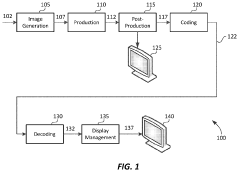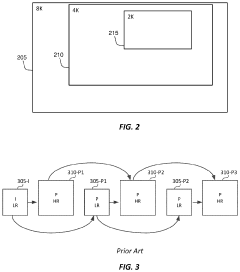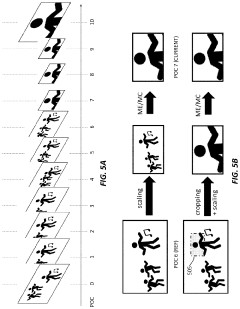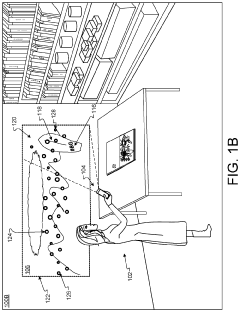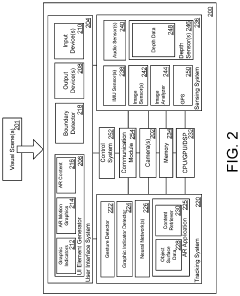How Dolby Vision Refines Motion Graphics Production
JUL 30, 20259 MIN READ
Generate Your Research Report Instantly with AI Agent
Patsnap Eureka helps you evaluate technical feasibility & market potential.
Dolby Vision Evolution
Dolby Vision has undergone a remarkable evolution since its inception, transforming the landscape of motion graphics production. Initially introduced as a high dynamic range (HDR) imaging technology for cinema and home entertainment, Dolby Vision has expanded its reach to encompass a wide array of content creation processes, including motion graphics.
The journey of Dolby Vision began with its focus on enhancing the visual experience through increased brightness, contrast, and color gamut. As the technology matured, it became evident that its potential extended far beyond traditional video content. The evolution of Dolby Vision in motion graphics production can be traced through several key milestones.
Early adoption in the film industry paved the way for Dolby Vision's integration into motion graphics workflows. Post-production houses and visual effects studios recognized the technology's ability to preserve creative intent across various display devices. This realization led to the development of specialized tools and plugins that allowed motion graphics artists to work directly in the Dolby Vision format.
As consumer displays capable of reproducing Dolby Vision content became more prevalent, the demand for HDR motion graphics increased. This shift prompted software developers to incorporate Dolby Vision support into popular motion graphics applications, enabling artists to create and preview their work in real-time with the full dynamic range and color depth offered by the technology.
The evolution of Dolby Vision in motion graphics production also saw the introduction of content-aware metadata. This innovation allowed for dynamic adjustments to brightness and color based on the specific characteristics of each frame, ensuring optimal presentation across a variety of viewing environments and devices.
Recent advancements have focused on streamlining the Dolby Vision workflow for motion graphics artists. Improved color management systems and rendering engines now offer seamless integration with existing production pipelines, reducing the complexity of working with high dynamic range content. Additionally, the development of AI-assisted tools has further refined the process of creating and optimizing Dolby Vision motion graphics.
The latest phase in Dolby Vision's evolution addresses the challenges of delivering consistent experiences across diverse platforms. With the proliferation of streaming services and mobile devices, Dolby Vision has adapted to ensure that motion graphics maintain their visual impact regardless of the viewing medium. This has led to the implementation of intelligent tone mapping algorithms and device-specific optimizations.
As Dolby Vision continues to evolve, its influence on motion graphics production grows more profound. The technology not only enhances the visual quality of content but also expands the creative possibilities available to artists, allowing for more nuanced and impactful storytelling through motion graphics.
The journey of Dolby Vision began with its focus on enhancing the visual experience through increased brightness, contrast, and color gamut. As the technology matured, it became evident that its potential extended far beyond traditional video content. The evolution of Dolby Vision in motion graphics production can be traced through several key milestones.
Early adoption in the film industry paved the way for Dolby Vision's integration into motion graphics workflows. Post-production houses and visual effects studios recognized the technology's ability to preserve creative intent across various display devices. This realization led to the development of specialized tools and plugins that allowed motion graphics artists to work directly in the Dolby Vision format.
As consumer displays capable of reproducing Dolby Vision content became more prevalent, the demand for HDR motion graphics increased. This shift prompted software developers to incorporate Dolby Vision support into popular motion graphics applications, enabling artists to create and preview their work in real-time with the full dynamic range and color depth offered by the technology.
The evolution of Dolby Vision in motion graphics production also saw the introduction of content-aware metadata. This innovation allowed for dynamic adjustments to brightness and color based on the specific characteristics of each frame, ensuring optimal presentation across a variety of viewing environments and devices.
Recent advancements have focused on streamlining the Dolby Vision workflow for motion graphics artists. Improved color management systems and rendering engines now offer seamless integration with existing production pipelines, reducing the complexity of working with high dynamic range content. Additionally, the development of AI-assisted tools has further refined the process of creating and optimizing Dolby Vision motion graphics.
The latest phase in Dolby Vision's evolution addresses the challenges of delivering consistent experiences across diverse platforms. With the proliferation of streaming services and mobile devices, Dolby Vision has adapted to ensure that motion graphics maintain their visual impact regardless of the viewing medium. This has led to the implementation of intelligent tone mapping algorithms and device-specific optimizations.
As Dolby Vision continues to evolve, its influence on motion graphics production grows more profound. The technology not only enhances the visual quality of content but also expands the creative possibilities available to artists, allowing for more nuanced and impactful storytelling through motion graphics.
Market Demand Analysis
The market demand for Dolby Vision in motion graphics production has been steadily increasing, driven by the growing consumer appetite for high-quality visual content across various platforms. As streaming services, gaming, and digital advertising continue to evolve, the need for enhanced visual experiences has become paramount, positioning Dolby Vision as a key technology in meeting these demands.
The rise of 4K and HDR-capable displays in homes and mobile devices has created a significant market opportunity for Dolby Vision-enhanced content. Consumers are increasingly expecting vibrant, lifelike visuals in their entertainment, leading content creators and distributors to seek technologies that can deliver superior image quality. This trend has been particularly noticeable in the streaming industry, where platforms compete to offer the most immersive viewing experiences.
In the motion graphics sector, Dolby Vision's ability to refine production processes and enhance visual output has garnered substantial interest. Professional content creators, including those in advertising, film, and television, are recognizing the technology's potential to elevate their work and meet the rising standards of visual quality demanded by both clients and audiences.
The gaming industry has also shown a growing demand for Dolby Vision technology. As game developers strive to create more realistic and visually stunning environments, the incorporation of advanced HDR technologies like Dolby Vision has become increasingly important. This demand extends to both console and PC gaming markets, where visual fidelity is a key differentiator.
Market research indicates that the global HDR market, of which Dolby Vision is a significant part, is experiencing robust growth. The technology's ability to enhance contrast, color accuracy, and overall visual quality aligns well with the current market trends towards more immersive and high-fidelity visual experiences.
Furthermore, the adoption of Dolby Vision in professional production workflows has been driven by its potential to streamline post-production processes. The technology's ability to maintain consistent color and brightness across different displays and viewing environments has made it particularly attractive to studios and production houses looking to optimize their workflows and ensure the highest quality output across various distribution channels.
As the demand for high-quality visual content continues to grow across multiple industries, including entertainment, advertising, and gaming, the market for technologies like Dolby Vision in motion graphics production is expected to expand further. This growth is likely to be sustained by ongoing advancements in display technologies and the increasing consumer expectation for premium visual experiences across all platforms and devices.
The rise of 4K and HDR-capable displays in homes and mobile devices has created a significant market opportunity for Dolby Vision-enhanced content. Consumers are increasingly expecting vibrant, lifelike visuals in their entertainment, leading content creators and distributors to seek technologies that can deliver superior image quality. This trend has been particularly noticeable in the streaming industry, where platforms compete to offer the most immersive viewing experiences.
In the motion graphics sector, Dolby Vision's ability to refine production processes and enhance visual output has garnered substantial interest. Professional content creators, including those in advertising, film, and television, are recognizing the technology's potential to elevate their work and meet the rising standards of visual quality demanded by both clients and audiences.
The gaming industry has also shown a growing demand for Dolby Vision technology. As game developers strive to create more realistic and visually stunning environments, the incorporation of advanced HDR technologies like Dolby Vision has become increasingly important. This demand extends to both console and PC gaming markets, where visual fidelity is a key differentiator.
Market research indicates that the global HDR market, of which Dolby Vision is a significant part, is experiencing robust growth. The technology's ability to enhance contrast, color accuracy, and overall visual quality aligns well with the current market trends towards more immersive and high-fidelity visual experiences.
Furthermore, the adoption of Dolby Vision in professional production workflows has been driven by its potential to streamline post-production processes. The technology's ability to maintain consistent color and brightness across different displays and viewing environments has made it particularly attractive to studios and production houses looking to optimize their workflows and ensure the highest quality output across various distribution channels.
As the demand for high-quality visual content continues to grow across multiple industries, including entertainment, advertising, and gaming, the market for technologies like Dolby Vision in motion graphics production is expected to expand further. This growth is likely to be sustained by ongoing advancements in display technologies and the increasing consumer expectation for premium visual experiences across all platforms and devices.
Technical Challenges
Dolby Vision's integration into motion graphics production presents several technical challenges that require innovative solutions. One of the primary obstacles is the complexity of managing high dynamic range (HDR) content within traditional motion graphics workflows. Many existing tools and software packages were designed for standard dynamic range (SDR) content, making it difficult to accurately preview and manipulate HDR elements.
The increased color depth and luminance range of Dolby Vision content also pose challenges in terms of color management and grading. Motion graphics artists must adapt to working with wider color gamuts and higher bit depths, which can be particularly demanding when creating seamless transitions between graphical elements and live-action footage.
Another significant hurdle is the need for specialized hardware and displays capable of accurately representing Dolby Vision content during the production process. Many studios and freelance artists may not have access to the necessary equipment, limiting their ability to fully leverage the technology's capabilities.
Rendering and processing times for Dolby Vision-compatible motion graphics can be substantially longer than those for traditional SDR content. This increased computational demand can impact production schedules and require upgrades to existing hardware infrastructure.
Compatibility issues between different software packages and plugins used in motion graphics production can also arise when working with Dolby Vision. Ensuring smooth integration and data exchange between various tools in the production pipeline is crucial but often challenging.
The dynamic metadata aspect of Dolby Vision introduces additional complexity to the motion graphics workflow. Artists must consider how their creations will be optimized for different display capabilities, requiring a deeper understanding of the technology's underlying principles.
Furthermore, the need for consistent viewing experiences across various devices and platforms presents challenges in terms of content delivery and playback. Motion graphics artists must consider how their work will be interpreted and displayed on a wide range of Dolby Vision-enabled devices, from high-end televisions to mobile phones.
Lastly, the relative newness of Dolby Vision in the motion graphics field means there is a learning curve for many professionals. Acquiring the necessary skills and knowledge to effectively work with this technology can be time-consuming and may require significant investment in training and resources.
The increased color depth and luminance range of Dolby Vision content also pose challenges in terms of color management and grading. Motion graphics artists must adapt to working with wider color gamuts and higher bit depths, which can be particularly demanding when creating seamless transitions between graphical elements and live-action footage.
Another significant hurdle is the need for specialized hardware and displays capable of accurately representing Dolby Vision content during the production process. Many studios and freelance artists may not have access to the necessary equipment, limiting their ability to fully leverage the technology's capabilities.
Rendering and processing times for Dolby Vision-compatible motion graphics can be substantially longer than those for traditional SDR content. This increased computational demand can impact production schedules and require upgrades to existing hardware infrastructure.
Compatibility issues between different software packages and plugins used in motion graphics production can also arise when working with Dolby Vision. Ensuring smooth integration and data exchange between various tools in the production pipeline is crucial but often challenging.
The dynamic metadata aspect of Dolby Vision introduces additional complexity to the motion graphics workflow. Artists must consider how their creations will be optimized for different display capabilities, requiring a deeper understanding of the technology's underlying principles.
Furthermore, the need for consistent viewing experiences across various devices and platforms presents challenges in terms of content delivery and playback. Motion graphics artists must consider how their work will be interpreted and displayed on a wide range of Dolby Vision-enabled devices, from high-end televisions to mobile phones.
Lastly, the relative newness of Dolby Vision in the motion graphics field means there is a learning curve for many professionals. Acquiring the necessary skills and knowledge to effectively work with this technology can be time-consuming and may require significant investment in training and resources.
Current Implementation
01 High Dynamic Range (HDR) Motion Graphics
Dolby Vision technology is utilized to create high dynamic range motion graphics, enhancing visual quality with improved contrast, brightness, and color accuracy. This technique allows for more vibrant and lifelike animations, particularly beneficial in digital signage, user interfaces, and video content creation.- High Dynamic Range (HDR) Motion Graphics: Dolby Vision technology is applied to motion graphics to enhance visual quality through HDR. This involves processing and displaying graphics with a wider range of colors and brightness levels, resulting in more vibrant and lifelike images. The technology adapts to different display capabilities, ensuring optimal viewing across various devices.
- Color Grading and Management for Motion Graphics: Specialized color grading techniques are employed for Dolby Vision motion graphics. This includes precise color mapping, tone mapping, and color space conversions to maintain the intended visual aesthetics across different display technologies. Advanced algorithms are used to preserve color accuracy and detail in both bright and dark areas of the graphics.
- Real-time Rendering and Processing: Dolby Vision motion graphics often require real-time rendering and processing capabilities. This involves optimizing graphics pipelines, utilizing hardware acceleration, and implementing efficient algorithms to handle the increased data load of HDR content. The goal is to maintain smooth playback and interactivity while delivering high-quality visuals.
- Adaptive Display Technologies: Motion graphics in Dolby Vision are designed to adapt to various display technologies and viewing environments. This includes dynamic adjustment of brightness, contrast, and color based on ambient light conditions and display capabilities. The system ensures optimal viewing experience across a range of devices, from mobile screens to large format displays.
- Integration with Audio and User Interface: Dolby Vision motion graphics are often integrated with advanced audio technologies and user interface elements. This creates a cohesive audiovisual experience, with graphics that respond to sound and user interactions. The integration considers factors such as synchronization, spatial audio, and interactive elements to enhance overall user engagement.
02 Color Grading and Management for Motion Graphics
Advanced color grading and management techniques are applied to motion graphics using Dolby Vision standards. This process ensures consistent color representation across various display devices, optimizing the visual experience for viewers regardless of the playback hardware.Expand Specific Solutions03 Real-time Rendering of Dolby Vision Motion Graphics
Systems and methods for real-time rendering of Dolby Vision motion graphics are developed, allowing for dynamic content creation and adjustment. This technology enables interactive applications, live broadcasts, and responsive user interfaces that can adapt to changing viewing conditions or user inputs.Expand Specific Solutions04 Integration of 3D Elements in Dolby Vision Motion Graphics
Techniques for seamlessly integrating 3D elements into Dolby Vision motion graphics are implemented. This approach combines the depth and realism of 3D graphics with the enhanced visual quality of Dolby Vision, creating immersive and engaging visual experiences for various applications.Expand Specific Solutions05 Optimized Compression for Dolby Vision Motion Graphics
Specialized compression algorithms are developed to optimize the file size and streaming performance of Dolby Vision motion graphics. These methods maintain the high visual quality inherent to Dolby Vision while ensuring efficient delivery and playback across various platforms and network conditions.Expand Specific Solutions
Key Industry Players
The motion graphics production landscape for Dolby Vision is evolving rapidly, with the market in its growth phase. As the demand for high-quality visual content increases, the market size for Dolby Vision-enhanced motion graphics is expanding. The technology's maturity is advancing, with key players like Dolby Laboratories Licensing Corp. leading innovation. Companies such as Adobe, Inc. and Sony Group Corp. are integrating Dolby Vision capabilities into their software and hardware offerings, respectively. Other major players like Samsung Electronics Co., Ltd. and LG Electronics are also adopting this technology, indicating its growing importance in the industry. The competitive landscape is characterized by a mix of established tech giants and specialized firms, all vying to leverage Dolby Vision's potential in enhancing visual experiences across various platforms.
Dolby Laboratories Licensing Corp.
Technical Solution: Dolby Vision refines motion graphics production by implementing dynamic metadata and high dynamic range (HDR) capabilities. This technology allows for frame-by-frame optimization of brightness, color, and contrast, resulting in more vivid and lifelike images. Dolby Vision supports up to 12-bit color depth, enabling a palette of over 68 billion colors[1]. The system uses perceptual quantization (PQ) curve for luminance encoding, which more closely matches human visual perception[2]. Additionally, Dolby Vision incorporates advanced color grading tools that enable creators to precisely control the look of their content across various display capabilities[3].
Strengths: Superior image quality, wide color gamut, and compatibility with various display technologies. Weaknesses: Requires specialized hardware and software, potentially increasing production costs.
Adobe, Inc.
Technical Solution: Adobe has integrated Dolby Vision support into its Creative Suite, particularly in After Effects and Premiere Pro. This integration allows motion graphics artists to create, edit, and deliver Dolby Vision content directly within familiar workflows. Adobe's implementation includes tools for HDR color grading, luminance mapping, and metadata generation specific to Dolby Vision standards[4]. The software provides real-time previews of how content will appear on different display types, from SDR to HDR. Adobe has also developed AI-powered tools that assist in automating certain aspects of the Dolby Vision workflow, such as shot matching and color consistency across scenes[5].
Strengths: Seamless integration with industry-standard software, extensive toolset for Dolby Vision workflows. Weaknesses: Steep learning curve for new users, high system requirements for optimal performance.
Core Innovations
Video coding using reference picture resampling supporting region of interest
PatentActiveUS20220286667A1
Innovation
- The implementation of reference picture resampling (RPR) with support for region of interest (ROI) in video coding, allowing for flexible scaling and decoding of specific regions within a video frame, enabling scalable distribution of HDR content compatible with various display resolutions and devices.
Generating and rendering motion graphics effects based on recognized content in camera view finder
PatentPendingUS20230113461A1
Innovation
- A system that uses computer vision and machine learning to detect graphic indicators in a visual scene, generating Augmented Reality (AR) motion graphics within defined boundaries, providing visual feedback and allowing users to access additional content through immersive AR experiences.
Workflow Integration
Dolby Vision's integration into motion graphics production workflows represents a significant advancement in the field of visual content creation. This integration streamlines the process of creating high dynamic range (HDR) content while maintaining color accuracy and consistency across various display devices.
The workflow integration begins with the capture phase, where Dolby Vision-enabled cameras can record metadata alongside the video footage. This metadata contains crucial information about the color volume and dynamic range of the captured scene, which is essential for preserving the creator's intent throughout the post-production process.
In the editing and compositing stages, Dolby Vision-compatible software tools allow artists to work with the full range of colors and brightness levels captured in the original footage. These tools provide real-time previews of how the content will appear on different display types, from standard dynamic range (SDR) to HDR screens, ensuring that the visual elements remain consistent across various viewing environments.
Color grading is a critical step in the Dolby Vision workflow. The technology enables colorists to create a single master that can be automatically optimized for different display capabilities. This approach, known as single-stream HDR mastering, significantly reduces the time and resources required for creating multiple versions of the same content for different display technologies.
The integration of Dolby Vision also extends to the rendering and export processes. Motion graphics artists can render their work in Dolby Vision format, preserving the full dynamic range and color information. This ensures that the final output maintains the visual quality intended by the creators, regardless of the playback device's capabilities.
Furthermore, Dolby Vision's workflow integration includes quality control tools that allow for the verification of HDR content across various display scenarios. These tools help identify potential issues with color, brightness, and contrast before the content is distributed, reducing the need for costly revisions and re-exports.
The seamless integration of Dolby Vision into motion graphics production workflows not only enhances the visual quality of the final product but also improves efficiency throughout the creation process. By providing a standardized approach to HDR content creation, Dolby Vision enables artists to focus on their creative vision while ensuring that their work is optimized for a wide range of viewing experiences.
The workflow integration begins with the capture phase, where Dolby Vision-enabled cameras can record metadata alongside the video footage. This metadata contains crucial information about the color volume and dynamic range of the captured scene, which is essential for preserving the creator's intent throughout the post-production process.
In the editing and compositing stages, Dolby Vision-compatible software tools allow artists to work with the full range of colors and brightness levels captured in the original footage. These tools provide real-time previews of how the content will appear on different display types, from standard dynamic range (SDR) to HDR screens, ensuring that the visual elements remain consistent across various viewing environments.
Color grading is a critical step in the Dolby Vision workflow. The technology enables colorists to create a single master that can be automatically optimized for different display capabilities. This approach, known as single-stream HDR mastering, significantly reduces the time and resources required for creating multiple versions of the same content for different display technologies.
The integration of Dolby Vision also extends to the rendering and export processes. Motion graphics artists can render their work in Dolby Vision format, preserving the full dynamic range and color information. This ensures that the final output maintains the visual quality intended by the creators, regardless of the playback device's capabilities.
Furthermore, Dolby Vision's workflow integration includes quality control tools that allow for the verification of HDR content across various display scenarios. These tools help identify potential issues with color, brightness, and contrast before the content is distributed, reducing the need for costly revisions and re-exports.
The seamless integration of Dolby Vision into motion graphics production workflows not only enhances the visual quality of the final product but also improves efficiency throughout the creation process. By providing a standardized approach to HDR content creation, Dolby Vision enables artists to focus on their creative vision while ensuring that their work is optimized for a wide range of viewing experiences.
Content Creator Impact
Dolby Vision's impact on content creators in the motion graphics production industry has been transformative, offering new possibilities for visual storytelling and enhancing the overall quality of digital content. This advanced HDR technology has empowered creators to push the boundaries of their artistic vision, enabling them to produce more vibrant, dynamic, and immersive visual experiences.
One of the most significant impacts of Dolby Vision on content creators is the expanded color palette and contrast range it provides. Motion graphics artists now have access to a broader spectrum of colors and more nuanced shades, allowing for greater precision in color grading and more accurate representation of their creative intent. This enhanced color capability enables artists to create more visually striking and emotionally resonant graphics, elevating the overall impact of their work.
The increased dynamic range offered by Dolby Vision has also revolutionized how content creators approach lighting and contrast in their motion graphics. With the ability to display deeper blacks and brighter highlights, artists can now create more realistic and dramatic scenes, adding depth and dimensionality to their designs. This expanded range of luminance values allows for more subtle gradations and improved detail in both shadows and highlights, resulting in more visually compelling and lifelike motion graphics.
Furthermore, Dolby Vision has streamlined the workflow for content creators by providing a standardized format that ensures consistent color and brightness across various display devices. This consistency allows artists to have greater confidence that their work will be viewed as intended, regardless of the end-user's display capabilities. The technology's metadata-driven approach also enables dynamic optimization of content for different viewing environments, reducing the need for multiple versions of the same project.
The adoption of Dolby Vision has also encouraged content creators to explore new creative techniques and push the boundaries of what's possible in motion graphics. Artists are now experimenting with high-contrast scenes, intricate color gradients, and more complex lighting setups that were previously challenging to execute effectively. This has led to a renaissance in motion graphics design, with creators developing innovative visual styles that take full advantage of the technology's capabilities.
Moreover, Dolby Vision has influenced the way content creators approach project planning and asset creation. The technology's requirements have prompted artists to consider HDR compatibility from the early stages of production, leading to more thoughtful and deliberate design choices. This shift in mindset has resulted in higher-quality outputs and a more efficient production process overall.
One of the most significant impacts of Dolby Vision on content creators is the expanded color palette and contrast range it provides. Motion graphics artists now have access to a broader spectrum of colors and more nuanced shades, allowing for greater precision in color grading and more accurate representation of their creative intent. This enhanced color capability enables artists to create more visually striking and emotionally resonant graphics, elevating the overall impact of their work.
The increased dynamic range offered by Dolby Vision has also revolutionized how content creators approach lighting and contrast in their motion graphics. With the ability to display deeper blacks and brighter highlights, artists can now create more realistic and dramatic scenes, adding depth and dimensionality to their designs. This expanded range of luminance values allows for more subtle gradations and improved detail in both shadows and highlights, resulting in more visually compelling and lifelike motion graphics.
Furthermore, Dolby Vision has streamlined the workflow for content creators by providing a standardized format that ensures consistent color and brightness across various display devices. This consistency allows artists to have greater confidence that their work will be viewed as intended, regardless of the end-user's display capabilities. The technology's metadata-driven approach also enables dynamic optimization of content for different viewing environments, reducing the need for multiple versions of the same project.
The adoption of Dolby Vision has also encouraged content creators to explore new creative techniques and push the boundaries of what's possible in motion graphics. Artists are now experimenting with high-contrast scenes, intricate color gradients, and more complex lighting setups that were previously challenging to execute effectively. This has led to a renaissance in motion graphics design, with creators developing innovative visual styles that take full advantage of the technology's capabilities.
Moreover, Dolby Vision has influenced the way content creators approach project planning and asset creation. The technology's requirements have prompted artists to consider HDR compatibility from the early stages of production, leading to more thoughtful and deliberate design choices. This shift in mindset has resulted in higher-quality outputs and a more efficient production process overall.
Unlock deeper insights with Patsnap Eureka Quick Research — get a full tech report to explore trends and direct your research. Try now!
Generate Your Research Report Instantly with AI Agent
Supercharge your innovation with Patsnap Eureka AI Agent Platform!
